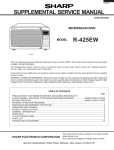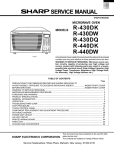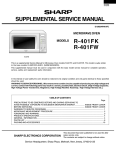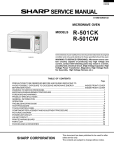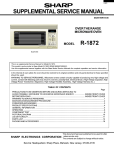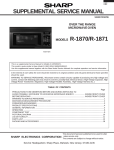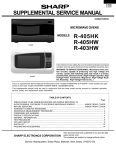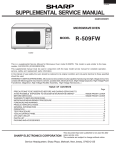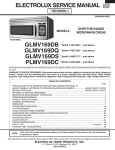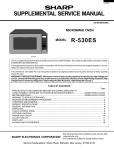Download Sharp R-419CK Service manual
Transcript
R- 419CK SUPPLEMENTAL SERVICE MANUAL S100M140R419E MICROWAVE OVEN MODEL R-419CK In the interest of user-safety the oven should be restored to its original condition and only parts identical to those specified should be used. R-419CK WARNING TO SERVICE PERSONNEL: Microwave ovens contain circuitry capable of producing very high voltage and current, contact with following parts may result in a severe, possibly fatal, electrical shock. (High Voltage Capacitor, High Voltage Power Transformer, Magnetron, High Voltage Rectifier Assembly, High Voltage Harness etc..) This is a supplemental Service Manual for Microwave Oven model R-419CK. This model is quite similar to the base model R-420CK (S/M# S49M132R420CE). This supplemental manual must be used in conjunction with the base model service manual for complete operation, service, safety and replacement parts information. TABLE OF CONTENTS Page PRECAUTIONS TO BE OBSERVED BEFORE AND DURING SERVICING TO AVOID POSSIBLE EXPOSURE TO EXCESSIVE MICROWAVE ENERGY .................... INSIDE FRONT COVER BEFORE SERVICING ...................................................................................................... INSIDE FRONT COVER WARNING TO SERVICE PERSONNEL ............................................................................................................... 1 MICROWAVE MEASUREMENT PROCEDURE ................................................................................................... 2 FOREWORD AND WARNING ............................................................................................................................. 3 PRODUCT SPECIFICATIONS ............................................................................................................................. 4 GENERAL INFORMATION ................................................................................................................................. 5 OPERATION ........................................................................................................................................................ 6 TEST PROCEDURE ............................................................................................................................................ 8 PICTORIAL DIAGRAM ....................................................................................................................................... 11 LSI UNIT CIRCUIT ............................................................................................................................................. 12 PARTS LIST ....................................................................................................................................................... 13 PACKING AND ACCESSORIES ........................................................................................................................ 17 SHARP ELECTRONCS CORPORATION This document has been published to be used for after sales service only. The contents are subject to change without notice. Service Headquarters: Sharp Plaza, Mahwah, New Jersey, 07430-2135 R-419CK PRECAUTIONS TO BE OBSERVED BEFORE AND DURING SERVICING TO AVOID POSSIBLE EXPOSURE TO EXCESSIVE MICROWAVE ENERGY (a) Do not operate or allow the oven to be operated with the door open. (b) Make the following safety checks on all ovens to be serviced before activating the magnetron or other microwave source, and make repairs as necessary: (1) interlock operation, (2) proper door closing, (3) seal and sealing surfaces (arcing, wear, and other damage), (4) damage to or loosening of hinges and latches, (5) evidence of dropping or abuse. (c) Before turning on microwave power for any service test or inspection within the microwave generating compartments, check the magnetron, wave guide or transmission line, and cavity for proper alignment, integrity, and connections. (d) Any defective or misadjusted components in the interlock, monitor, door seal, and microwave generation and transmission systems shall be repaired, replaced, or adjusted by procedures described in this manual before the oven is released to the owner. (e) A microwave leakage check to verify compliance with the Federal Performance Standard should be performed on each oven prior to release to the owner. BEFORE SERVICING Before servicing an operative unit, perform a microwave emission check as per the Microwave Measurement Procedure outlined in this service manual. If microwave emissions level is in excess of the specified limit, contact SHARP ELECTRONICS CORPORATION immediately @1-800-237-4277. If the unit operates with the door open, service person should 1) tell the user not to operate the oven and 2) contact SHARP ELECTRONICS CORPORATION and Food and Drug Administration's Center for Devices and Radiological Health immediately. Service personnel should inform SHARP ELECTRONICS CORPORATION of any certified unit found with emissions in excess of 4mW/cm2. The owner of the unit should be instructed not to use the unit until the oven has been brought into compliance. R-419CK WARNING TO SERVICE PERSONNEL Microwave ovens contain circuitry capable of producing very high voltage and current, contact with following parts may result in a severe, possibly fatal, electrical shock. (Example) High Voltage Capacitor, High Voltage Power Transformer, Magnetron, High Voltage Rectifier Assembly, High Voltage Harness etc.. Read the Service Manual carefully and follow all instructions. Don't Touch ! Danger High Voltage When the testing is completed, 1. Disconnect the power supply cord, and then remove outer case. 2. Open the door and block it open. 3. Discharge high voltage capacitor. 4. Reconnect the leads to the primary of the power transformer. 5. Reinstall the outer case (cabinet). 6. Reconnect the power supply cord after the outer case is installed. 7. Run the oven and check all functions. Before Servicing 1. Disconnect the power supply cord remove outer case. 2. Open the door and block it open. 3. Discharge high voltage capacitor. , and then WARNING:RISK OF ELECTRIC SHOCK. DISCHARGE THE HIGH-VOLTAGE CAPACITOR BEFORE SERVICING. After repairing The high-voltage capacitor remains charged about 60 seconds after the oven has been switched off. Wait for 60 seconds and then short-circuit the connection of the highvoltage capacitor (that is the connecting lead of the highvoltage rectifier) against the chassis with the use of an insulated screwdriver. 1. Reconnect all leads removed from components during testing. 2. Reinstall the outer case (cabinet). 3. Reconnect the power supply cord after the outer case is installed. 4. Run the oven and check all functions. Whenever troubleshooting is performed the power supply must be disconnected. It may in, some cases, be necessary to connect the power supply after the outer case has been removed, in this event, 1. Disconnect the power supply cord, and then remove outer case. 2. Open the door and block it open. 3. Discharge high voltage capacitor. 4. Disconnect the leads to the primary of the power transformer. 5. Ensure that the leads remain isolated from other components and oven chassis by using insulation tape. 6. After that procedure, reconnect the power supply cord. Microwave ovens should not be run empty. To test for the presence of microwave energy within a cavity, place a cup of cold water on the oven turntable, close the door and set the power to HIGH and set the microwave timer for two (2) minutes. When the two minutes has elapsed (timer at zero) carefully check that the water is now hot. If the water remains cold carry out Before Servicing procedure and reexamine the connections to the component being tested. When all service work is completed and the oven is fully assembled, the microwave power output should be checked and a microwave leakage test should be carried out. 1 R- 419CK MICROWAVE MEASUREMENT PROCEDURE A. Requirements: 1) Microwave leakage limit (Power density limit): The power density of microwave radiation emitted by a microwave oven should not exceed 1mW/cm2 at any point 5cm or more from the external surface of the oven, measured prior to acquisition by a purchaser, and thereafter (through the useful life of the oven), 5 mW/cm2 at any point 5cm or more from the external surface of the oven. 2) Safety interlock switches Primary interlock relay and door sensing switch shall prevent microwave radiation emission in excess of the requirement as above mentioned, secondary interlock switch shall prevent microwave radiation emission in excess of 5 mW/cm2 at any point 5cm or more from the external surface of the oven. B. Preparation for testing: Before beginning the actual measurement of leakage, proceed as follows: 1) Make sure that the actual instrument is operating normally as specified in its instruction booklet. Important: Survey instruments that comply with the requirement for instrumentation as prescribed by the performance standard for microwave ovens, 21 CFR 1030.10(c)(3)(i), must be used for testing. 2) Place the oven tray in the oven cavity. 3) Place the load of 275±15 ml (9.8 oz) of tap water initially at 20±5O C (68OF) in the center of the oven cavity. The water container shall be a low form of 600 ml (20 oz) beaker with an inside diameter of approx. 8.5 cm (3-1/2 in.) and made of an electrically nonconductive material such as glass or plastic. The placing of this standard load in the oven is important not only to protect the oven, but also to insure that any leakage is measured accurately. 4) Set the cooking control on Full Power Cooking Mode. 5) Close the door and select a cook cycle of several minutes. If the water begins to boil before the survey is completed, replace it with 275 ml of cool water. C. Leakage test: Closed-door leakage test (microwave measurement) 1) Grasp the probe of the survey instrument and hold it perpendicular to the gap between the door and the body of the oven. 2) Move the probe slowly, not faster than 1 in./sec. (2.5 cm/sec.) along the gap, watching for the maximum indication on the meter. 3) Check for leakage at the door screen, sheet metal seams and other accessible positions where the continuity of the metal has been breached (eg., around the switches, indicator, and vents). While testing for leakage around the door pull the door away from the front of the oven as far as is permitted by the closed latch assembly. 4) Measure carefully at the point of highest leakage and make sure that the highest leakage is no greater than 4mW/cm2, and that the secondary interlock switch does turn the oven OFF before any door movement. NOTE: After servicing, record data on service invoice and microwave leakage report. 2 R-419CK SERVICE MANUAL PRODUCT DESCRIPTION MICROWAVE OVEN R-419CK FOREWORD GENERAL INFORMATION This Manual has been prepared to provide Sharp Electronics Corp. Service Personnel with Operation and Service Information for the SHARP MICROWAVE OVEN, R-419CK. It is recommended that service personnel carefully study the entire text of this manual so that they will be qualified to render satisfactory customer service. OPERATION TROUBLESHOOTING GUIDE AND TEST PROCEDURE Check the interlock switches and the door seal carefully. Special attention should be given to avoid electrical shock and microwave radiation hazard. WIRING DIAGRAM WARNING Never operate the oven until the following points are ensured. (A) The door is tightly closed. (B) The door brackets and hinges are not defective. (C) The door packing is not damaged. (D) The door is not deformed or warped. (E) There is no other visible damage with the oven. Servicing and repair work must be carried out only by trained service personnel. DANGER Certain initial parts are intentionally not grounded and present a risk of electrical shock only during servicing. Service personnel - Do not contact the following parts while the appliance is energized; High Voltage Capacitor, Power Transformer, Magnetron, High Voltage Rectifier Assembly, High Voltage Harness; If provided, Vent Hood, Fan assembly, Cooling Fan Motor. All the parts marked “*” on parts list are used at voltages more than 250V. Removal of the outer wrap gives access to voltage above 250V. All the parts marked “∆” on parts list may cause undue microwave exposure, by themselves, or when they are damaged, loosened or removed. SHARP ELECTRONICS CORPORATION SHARP PLAZA, MAHWAH, NEW JERSEY 07430-2135 3 PARTS LIST R- 419CK SPECIFICATION ITEM DESCRIPTION Power Requirements 120 Volts / 13.3 Amperes/1550Watts 60 Hertz Single phase, 3 wire grounded Power Output 1100 watts (IEC-705 TEST PROCEDURE) Operating frequency of 2450MHz Case Dimensions Width 21-11/16" Height 12-3/8" Depth 17-3/8" Cooking Cavity Dimensions 1.4 Cubic Feet Width Height Depth Tray Size Control Complement Touch Control System Clock ( 1:00 - 12:59 ) Timer (0 - 99 min. 99 seconds) Microwave Power for Variable Cooking Repetition Rate; P-HI ................................................. Full power throughout the cooking time P-90 .................................................................... approx. 90% of Full Power P-80 .................................................................... approx. 80% of Full Power P-70 .................................................................... approx. 70% of Full Power P-60 .................................................................... approx. 60% of Full Power P-50 .................................................................... approx. 50% of Full Power P-40 .................................................................... approx. 40% of Full Power P-30 .................................................................... approx. 30% of Full Power P-20 .................................................................... approx. 20% of Full Power P-10 .................................................................... approx. 10% of Full Power P-0 ..................................................... No power throughout the cooking time BEVERAGE pad MINUTE PLUS pad, INSTANT ACTION pads COMPU DEFROST pads, Number selection pads Power Level pad, Timer/Clock pad Stop/Clear pad, START pad Oven Cavity Light Yes Safety Standard UL Listed FCC Authorized DHHS Rules, CFR, Title 21, Chapter 1, Subchapter J 15" 9-7/16" 16-3/4" 14-1/8" Diameter GENERAL INFORMATION GROUNDING INSTRUCTIONS This oven is equipped with a three prong grounding plug. It must be plugged into a wall receptacle that is properly installed and grounded in accordance with the National Electrical Code and local codes and ordinances. In the event of an electrical short circuit, grounding reduces the risk of electric shock by providing an escape wire for the electric current. WARNING: Improper use of the grounding plug can result in a risk of electric shock. Electrical Requirements The electrical requirements are a 120 volt 60 Hz, AC only, 15 or 20 amp. fused electrical supply. It is recommended that a separate circuit serving only this appliance be provided. When installing this appliance, observe all applicable codes and ordinances. A short power-supply cord is provided to reduce risks of becoming entangled in or tripping over a longer cord. Where a two-pronged wall-receptacle is encountered, it is the personal responsibility and obligation of the customer to contact 4 R-419CK a qualified electrician and have it replaced with a properly grounded three-pronged wall receptacle or have a grounding adapter properly grounded and polarized. If the extension cord must be used, it should be a 3-wire, 15 amp. or higher rated cord. Do not drape over a countertop or table where it can be pulled on by children or tripped over accidentally. CAUTION: DO NOT UNDER ANY CIRCUMSTANCES CUT OR REMOVE THE ROUND GROUNDING PRONG FROM THIS PLUG. OVEN DIAGRAM 1. One touch door open button. Push to open door. 2. Door latches. The oven will not operate unless the door is securely closed. 3. Removable turntable support. 4. Removable turntable. The turntable will rotate clockwise or counterclockwise. 5. Oven lamp. It will light when oven is operating or door is opened. 6. Oven door with see-through window. 7. Ventilation openings. (Rear) 8. Auto-Touch control panel. 9. Time display: Digital display, 99 minutes 99 seconds. 5 6 7 9 11 8 10 2 1 4 3 10. Coupling. 11. Wave guide cover. 12. Power supply cord TOUCH CONTROL PANEL 5 12 R- 419CK OPERATION DESCRIPTION OF OPERATING SEQUENCE SENSOR COOKING CONDITION Using the SENSOR function, food is cooked without figuring time, power level or quantity. When the oven senses enough steam from the food, it relays the information to its microprocessor which will calculate the remaining cooking time and power level needed for best results. When the food is cooked, water vapor is developed. The sensor "senses" the vapour and its resistance increase gradually. When the resistance reaches the value set according to the menu, supplementary cooking is started. The time of supplementary cooking is determined by experiment with each food category and inputted into the LSI. An example of how sensor works: (Potatoes) 3.Sensor detects moisture and humidity and calculates cooking time and variable power. Cooking Sequence. 1. Touch one of the SENSOR pads. NOTE: The oven should not be operated on sensor immediately after plugging in the unit. Wait two minutes before cooking on SENSOR. 2. The coil of shut-off relay (RY-1) is energized, the turntable motor are turned on, but the power transformer is not turned on. 3. After about 16 seconds, the cook relay (RY-2) is energized. The power transformer is turned on, microwave energy is produced and first stage is started. The 16 seconds is the cooling time required to remove any vapor from the oven cavity and sensor. 1. Potatoes at room temperature. Vapor is emitted very slowly. NOTE: During this first stage, do not open the door or touch STOP/CLEAR pad. 4. When the sensor detects the vapor emitted from the food, the display switches over to the remaining cooking time and the timer counts down to zero. At this time, the door may be opened to stir, turn or season food. 5. When the timer reaches zero, an audible signal sounds. The shut-off relay and cook relay are de-energized and the power transformer, oven lamp, etc. are turned off. 6. Opening the door or touching the STOP/CLEAR pad, the time of the day will reappear on the display and the oven will revert to an OFF condition. When the timer reaches zero, an audible signal sounds. 2.Heat Potatoes. Moisture and humidity is emitted very rapidly. You can smell the aroma as it cooks. 6 R-419CK SCHEMATIC NOTE: CONDITION OF OVEN 1. Door Closed 2. CLOCK APPEARS ON DISPLAY MAGNETRON TEMP. FUSE Note:* Indicates component s with potentioal above 250V. MONITOR FUSE 20A COM. N.O. A2 CAPACITOR 1.0µF AC 2300V AH SENSOR (RY-2) PRIMARY INTERLOCK RELAY (RY-1) A1 GRN CONTROL UNIT N.O. COM. 120V AC 60 Hz B1 DOOR SENSING SWITCH CAVITY TEMP. FUSE TTM OL FM TURNTABLE MOTOR OVEN LAMP POWER TRANSFORMER B2 N.C. MONITOR SWITCH COM. H.V. RECTIFIER MAGNETRON FAN MOTOR SECONDARY INTERLOCK SWITCH Figure O-1 Oven Schematic - Off Condition SCHEMATIC NOTE: CONDITION OF OVEN 1. DOOR CLOSED 2. COOKING TIME PROGRAMMED 3. VARIABLE COOKING CONTROL "HIGH" 4. "START" PAD TOUCHED MAGNETRON TEMP. FUSE MONITOR FUSE 20A COM. N.O. A2 CAPACITOR 1.0µF AC 2300V AH SENSOR (RY-2) PRIMARY INTERLOCK RELAY (RY-1) A1 GRN CONTROL UNIT N.O. COM. 120V AC 60 Hz B1 CAVITY TEMP. FUSE DOOR SENSING SWITCH TTM OL TURNTABLE MOTOR OVEN LAMP FM POWER TRANSFORMER B2 N.C. MONITOR SWITCH COM. H.V. RECTIFIER MAGNETRON FAN MOTOR SECONDARY INTERLOCK SWITCH Figure O-2 Oven Schematic - Cooking Condition 7 R- 419CK TEST PROCEDURES PROCEDURE LETTER J COMPONENT TEST KEY UNIT TEST 1. Disconnect the power supply cord, and then remove outer case. 2. Open the door and block it open. 3. Discharge high voltage capacitor. 4. If the display fails to clear when the STOP/CLEAR pad is depressed, first verify the flat ribbon cable is making good contact, verify that the door sensing switch (stop switch) operates properly; that is the contacts are closed when the door is closed and open when the door is open. If the door sensing switch (stop switch) is good, disconnect the flat ribbon cable that connects the key unit to the control unit and make sure the door sensing switch is closed (either close the door or short the door sensing switch connecter). Use the Key unit matrix indicated on the control panel schematic and place a jumper wire between the pins that correspond to the STOP/CLEAR pad making momentary contact. If the control unit responds by clearing with a beep the key unit is faulty and must be replaced. If the control unit does not respond, it is faulty and must be replaced. If a specific pad does not respond, the above method may be used (after clearing the control unit) to determine if the control unit or key pad is at fault. 5. Reconnect all leads removed from components during testing. 6. Re-install the outer case (cabinet). 7. Reconnect the power supply cord after the outer case is installed. 8. Run the oven and check all functions. G7 G8 G6 G5 G4 G3 G9 5 4 3 2 1 G10 0 9 8 7 6 G11 MINUTE PLUS Frozen Rolls/ muffins Clock Kitchen Timer START BEVERAGE Power Level Fresh Rolls/ muffins CUSTOM Frozen HELP entrees Reheat G12 G13 Stop Clear Ground Meat (COMPU DEFROST) G2 G1 Chicken Pieces Steaks/ POPCORN Baked Chops Potatoes Frozen Vegetables Fresh vegetables Fish Ground Meat Seafood (SENSOR COOK) G14 Key Unit L COMPU DEFROST TEST WARNING : The oven should be fully assembled before following procedure. (1) Place one cup of water in the center of the turntable tray in the oven cavity. (2) Close the door, touch the " steaks / chops " pad once. (3) The oven is in Compu Defrost cooking condition. (4) The oven will operate as follows WEIGHT 0.5lb 1ST STAGE LEVEL TIME 60% 27sec. 2ND STAGE LEVEL TIME 40% 17sec. (5) If improper operation is indicated, the control unit is probably defective and should be checked. 8 R-419CK TEST PROCEDURES PROCEDURE LETTER N COMPONENT TEST AH SENSOR TEST Checking the initial sensor cooking condition Warning: The oven should be fully assembled before following procedure. 1) The oven should be plugged in at least two minutes before sensor cooking. 2) Room temperature should not exceed 95OF(35OC). 3) The unit should not be installed in any area where heat and steam are generated. The unit should not be installed for example, next to conventional surface unit. Refer to the "INSTALLATION INSTRUCTIONS" of the operational manual. (4) Exhaust vents are provided on the back of the unit for proper cooling and air flow in the cavity. To permit adequate ventilation, be sure to install so as not to block these vents. There should be some space for air circulation. (5) Be sure the exterior of the cooking container and the interior of the oven are dry. Wipe off any moisture with dry cloth or paper towel. (6) The Sensor works with food at normal storage temperature. For example, chicken pieces would be at refrigerator temperature and canned soup at room temperature. (7) Avoid using aerosol sprays or cleaning solvents near the oven while using Sensor settings. The sensor will detect the vapour given of by the spray and turn off before food is properly cooked. (8) If the sensor has not detected the vapour of the food, ERROR will appear and the oven will shut off. Water load cooking test Warning: The oven should be fully assembled before following procedure. Make sure the oven the oven has been plugged in at least two minutes before checking sensor cook operation . The cabinet should be installed and screws tightened. (1) The oven should be plugged in at least two minutes before sensor cooking. (2) Fill approximately 200 millilitres (7.2 oz) of tap water in 1000 millilitres measuring cup. (3) Place the container on the center of tray in the oven cavity. (4) Close the door. (5) Touch REHEAT pad once. Now, the oven is in the sensor cooking condition and " REHEAT" "SENSOR" will appear in the display. (6) The oven will operate for the first 16 seconds, without generating microwave energy. NOTE: ERROR will appear if the door is opened or STOP/CLEAR pad is touched during the first stage of sensor cooking. (7) After approximately 16 seconds, microwave energy is produced, and the display should start to count down the remaining cooking time and the oven should turn off after water is boiling (bubbling). If the oven does not turn off, replace the AH sensor or check the control unit, refer to explanation below. TESTING METHOD FOR AH SENSOR AND /OR CONTROL UNIT To determine if the sensor is defective, the simplest method is to replace it with a new replacement sensor. (1) Disconnect the power supply cord, and then remove outer case. (2) Open the door and block it open. (3) Discharge high voltage capacitor. (4)Remove the AH sensor. (5)Install the new AH sensor. (6)Reconnect all leads removed from components during testing. (7)Re-install the outer case (cabinet) (8) Reconnect the power supply cord after the outer case is installed. (9)Reconnect the oven to the power supply and check the sensor cook operation as follows: 9-1. Fill approximately 200 millilitres (7.2 oz) of tap water in a 1000 millilitre measuring cup. 9-2. Place the container on the center of tray in the oven cavity. 9-3. close the door. 9-4.Touch REHEAT pad once. 9-5.The control panel is in automatic sensor operation. 9-6.The display will start to count down the remaining cooking time, and the oven will turn off automatically after the water is boiling (bubbling). If new sensor does not operate properly, the problem is with the control unit, and refer to explanation below. 9 R- 419CK TEST PROCEDURES PROCEDURE LETTER COMPONENT TEST CHECKING CONTROL UNIT (1) Disconnect the power supply cord, and then remove outer case. (2) Open the door and block it open. (3) Discharge high voltage capacitor. (4) Disconnect the sensor connector that is mounted to control panel. (5) Then connect the dummy resistor circuit (see fig.) to the sensor connector of control panel. (6) Disconnect the leads to the primary of power transformer. (7) Ensure that these leads remain isolated from other components and oven chassis by using insulation tape. (8) After that procedure, re-connect the power supply cord. (9) Check the sensor cook operation proceed as follows: 9-1 Touch REHEAT pad once. 9-2 The control panel is in the sensor cooking operation. 9-3 After approximately 30 seconds, push plunger of select switch for more than 3 seconds. This condition is same as judgement by AH sensor. 9-4 After approximately 3 seconds, the display shows "xx.xx" which is remaining cooking time, and the display count down. If the above is not the case, the control unit is probably defective. If the above is proper, the AH sensor is probably defective. (10) Disconnect the power supply cord, and then remove outer case. (11) Open the door and block it open. (12) Discharge high voltage capacitor. (13) Reconnect the sensor connector that is mounted to control panel. (14) Carry out the necessary repair. (15) Reconnect all leads removed from components during testing and repairing. (16) Re-install the outer case (cabinet) (17) Reconnect the power supply cord after the outer case is installed. Run the oven and check all functions (18) Carry out the "water load cooking test" again and ensure that the oven work properly. 10 RED RED 1 MAGNETRON TEMP. FUSE WHT A WHT B C D E F G H 1 CAVITY TEMP. FUSE NOTE: The grounding conductor of the power supply cord has been grounded by power supply cord fixing screw. The screw must always be kept tight. RED H N WHT GRY DOOR SENSING SWITCH CONTROL UNIT N.O. PNK to Oven cavity (LSI UNIT) POWER SUPPLY CORD 120V 60Hz GRN 2 2 COM. GRN NOTE: The neutral (WHT/GRY) wire must be connected to the terminal with "N" mark on the power supply cord. GRN WHT 2 GRN 1 PNK 2 OVEN LAMP AND SOCKET COM. BLUE MARK 11 RY1 ORG 1 WHT N.O. BLU 1 2 CN-A NOTE: Hot (ORG) wire must be connected to the terminal with blue mark on the oven light socket. CN-A T1 COM. BRN RY2 FAN MOTOR 4 4 PRIMARY INTERLOCK RELAY ORG ORG WHT CN-B CN-B (POWER UNIT) BLK 3 3 1 ORG BLU N.O. HIGH VOLTAGE COMPONENTS RED RED WHT RED WHT N.C. RED COM. MONITOR SWITCH 5 5 MONITOR FUSE & HOLDER TURNTABLE MOTOR MAGNETRON HIGH VOLTAGE WIRE A BLK WHT SECONDARY NO INTERLOCK SWITCH COM. BRN WHT WHT GRY WHT WHT WHT HIGH VOLTAGE CAPACITOR RED H.V. RECTIFIER 6 6 POWER TRANSFORMER A B C D E F G H R-419CK Figure S-1. Pictorial Diagram R- 419CK 1 2 3 4 5 6 6 H G F E D A 5 A 4 B 3 B 2 C D E F G H 1 C 12 Figure S-3. CPU Unit Circuit R-419CK PARTS LIST Note: The parts marked “∆” may cause undue microwave exposure. The parts marked “*” are used in voltage more than 250V. "§" MARK: PARTS DELIVERY SECTION. REF. NO. PART NO. § DESCRIPTION Q'TY CODE 1- 1 1- 2 1- 3 1- 4 1- 5 1- 6 1- 7 1- 8 1- 9 1-10 1-11 1-12 1-13 1-14 1-15 RC-QZB018MRE0 FH-DZB013MRY0 QSOCLB006MRE0 RLMPTA068WRE0 RMOTEA346WRE0 QFSHDB003MRE0 FFS-BA016/KIT QSW-MA085WRE0 QFS-TA013WRE0 QFS-TA014WRE0 RV-MZA290WRE0 RMOTDA211/KIT RTRN-B065MRE0 FACCDB001MRE0 FDTCTA198WRK0 M M M M M M M M M M M M M M M High voltage capacitor High voltage rectifier assembly Oven lamp socket Oven lamp Fan motor Fuse holder Monitor switch (V-16G-2C25) and fuse assembly (20A 250V AC) Secondary interlock switch and door sensing switch (V-16G-3C25) O Magnetron temperature fuse O150 C Cavity temperature fuse 150 C Magnetron Turntable motor Power transformer Power supply cord AH sensor 1 1 1 1 1 1 1 2 1 1 1 1 1 1 1 AQ AK AE AE AR AD AF AE AE AF BC AL BD AL AN 2- 1 2- 2 2- 3 GDAI-B053MRP0 GLEGPB004MRF0 GCABUB097MRP0 M M M CABINET PARTS Base plate Foot Outer case cabinet 1 4 1 AR AB BC 3- 1 3- 1A 3- 1B 3- 1C C1 C2 C3 C4-5 D1-4 D5-8 Q1-2 Q3 R1 R2 R3 R4 R5 R6 RY1-2 RY1-2 SP1 T1 VRS1 ZD1 3- 2 3- 2-1 3- 2-2 3-2-3 3- 3 3- 4 3- 5 CPWBFB031MRU0 QCNCMA446DRE0 QCNCMA275DRE0 FW-VZB146MRE0 RC-KZA087DRE0 VCEAB31VW108M RC-KZA087DRE0 VCEAB31VW106M VHD11ES1///-1 VHD1SS270A/-1 VS2SB1238//-3 VSKRC243M//-3 VRD-B12EF242J VRD-B12HF681J VRD-B12HF511J VRD-B12EF270J VRD-B12EF472J VRD-B12EF332J RRLY-B002MRE0 RRLY-A113DRE0 RALM-A014DRE0 RTRNPB009MRE0 RH-VZA032DRE0 VHEHZ161///-1 FPNLCB311MRK0 FUNTKB192MRE0 JBTN-B092MRF0 MSPRTA050WRE0 LHLD-B009MRF0 PSHEPB023MRE0 XEPSD30P10XS0 M J J M J J J J J J J J J J J J J J J J J M J J M M M M M M M CONTROL PANEL PARTS Control unit 2-pin connector (CN-A) 2-pin connector (CN-B) 12Pin wire harness (CN-C) Capacitor 0.1 uF 50V Capacitor 1000 uF 35V Capacitor 0.1 uF 50V Capacitor 10 uF 35V Diode (11ES1) Diode (1SS270ATA) Transistor (2SB1238) Transistor (KRC243M) Resistor 2.4k ohm 1/4W Resistor 680 ohm 1/2W Resistor 510 ohm 1/2W Resistor 27 ohm 1/4W Resistor 4.7k ohm 1/4W Resistor 3.3k ohm 1/4W Relay (DU24D1-1P(M)) Relay (DU24D1-1P(M)) Interchangeable Buzzer (PKM22EPT) Transformer Varistor (10G471K) Zener diode (HZ16-1) Control panel frame with key unit Key unit Open button Open button spring LCD holder LED sheet Screw; 3mm x 10mm 1 1 1 1 1 1 1 1 4 4 2 1 1 1 1 1 1 1 2 2 1 1 1 1 1 1 1 1 1 1 1 BL AC AB AG AA AF AA AF AB AA AA AB AA AA AB AA AA AA AH AG AG AM AE AA AX AW AE AA AF AR AB 44444- LBNDKB007MRP0 LANGTB044MRP0 PHOK-B018MRF0 MLEVPB016MRF0 PDUC-B089MRF0 M M M M M OVEN PARTS H.V. Capacitor band Chassis support Latch hook Switch lever Magnetron duct 1 1 1 1 1 AB AE AF AD AF ELECTRIC PARTS * * * ∆ * 1 2 3 4 5 13 R- 419CK ∆ ∆ ∆ ∆ * REF. NO. 4- 6 4- 7 4- 8 4- 9 4-10 4-11 4-12 4-13 PART NO. NFANPB001MRE0 PDUC-B088MRF0 -----------PCOVPB073MRP0 PPACGB014MRF0 PDUC-B101MRP0 PCUSGB033MRP0 PCUSGB028MRP0 § M M M M M M M M DESCRIPTION Fan blade Fan duct Oven cavity (Not a replaceable part) Waveguide cover Turntable motor packing AH sensor duct Cushion Cushion 5 -1 5-1-1 5-1-2 5-2 5- 3 5- 4 5- 5 FCOV-B154MRK0 LSTPPB021MRF0 MSPRTA046WRE0 FDORFB062MRT0 PSHEPB021MRE0 GCOVHB041MRF0 HPNL-B087MRE0 M M M M M M M DOOR PARTS Door frame assembly [R-420CK] Latch head Latch spring Door panel Sealer film Choke cover Door screen 1 1 1 1 1 1 1 AV AD AB AV AE AG AK M M M M M M M M MISCELLANEOUS Stop switch harnnes Main wire harnnes High voltage wire A Turntable support Turntable tray Monitor caution label DHHS/Screw caution label Operation manual 1 1 1 1 1 1 1 1 AU AU AC AN AN AA AB AF M M M M M M M M M M SCREWS,NUTS AND WASHERS Special screw Special screw Screw : 4mm x 12mm Special screw Screw : 4mm x 12mm Screw : 3mm x 8mm Special screw Screw : 4mm x 8mm Special screw (Torx tamper proof screw) Screw : 3mm x 8mm 1 3 1 4 12 2 2 3 2 2 AA AA AA AA AA AA AA AA AC AA 66666666- 1 2 3 4 5 6 7 8 7- 1 7- 2 7- 3 7- 4 7- 5 7- 6 7- 7 7- 8 7-10 7-11 FW-VZB125MRE0 FW-VZB168MRE0 QW-QZB016MRE0 FROLPB025MRK0 NTNT-A095WRE0 TCAUAB037MRR0 TCAUAB038MRR0 TINSEB222MRR0 LX-BZA041WRE0 LX-CZ0052WRE0 XHTSD40P12RV0 LX-BZ0081YBE0 XOTSD40P12000 XCBSD30P08000 LX-CZA038WRE0 XHTSD40P08RV0 LX-CZA070WRE0 XCPSD30P08000 HOW TO ORDER REPLACEMENT PARTS To have your order filled promptly and correctly, please furnish the following information. 1. MODEL NUMBER 2. REF. NO. 3. PART NO. 4. DESCRIPTION Order Parts from the authorized SHARP parts Distributor for your area. Defective parts requiring return should be returned as indicated in the Service Policy. 14 Q'TY CODE 1 AC 1 AC 1 -1 AC 1 AA 1 AF 1 AA 1 AA R-419CK 2 1 4 3 OVEN AND CABINET PARTS 6 5 7-7 A A 7-9 7-7 2-3 B B 4-13 7-9 4-7 7-10 6-7 C C 1-5 4-6 7-3 7-6 1-14 D D 7-8 4-8 1-9 7-8 4-2 E E 7-5 1-11 1-3 4-9 7-2 1-4 7-2 6-5 1-8 7-5 7-4 4-3 F 4-5 F 4-10 1-12 1-13 7-6 1-7 1-8 2-1 4-4 6-4 1-6 7-1 6-6 4-1 G G 1-1 1-2 7-5 2-2 2-2 H 7-5 2-2 2 4-12 7-5 2-2 1 H 4 3 15 5 6 R- 419CK 2 1 4 3 6 5 CONTROL PANEL PARTS A A 3-1 3-3 3-4 3-2 3-5 B B 3-2-1 C C 3-2-2 3-2-3 D D 5-4 DOOR PARTS E E 5-2 5-5 5-3 F F MISCELLANEOUS 6-1 5-1-1 G G 5-1-2 6-3 5-1 6-2 H H Actual wire harness may be different from illustration. 1 2 4 3 16 5 6 R-419CK PACKING AND ACCESSORIES TOP PAD ASSEMBLY DOOR PROTECTION SHEET PLASTIC BAG TRAY HOLDER 6-5 TURNTABLE TRAY 6-8 OPERATION MANUAL Y VIT N VE CA EO TO 6-4 TURNTABLE SUPPORT TH IN BOTTOM PAD ASSEMBLY TRAY PACK SPADPB038MRE0 PACKING CASE Non-replaceable items. 17 R- 419CK COPYRIGHT © 1999 BY SHARP CORPORATION ALL RIGHTS RESERVED. No part of this publication may be reproduced, stored in retrieval systems, or transmitted in any form or by any means, electronic, mechanical, photocopying, recording, or otherwise, without prior written permission of the publisher. '2000 SHARP CORP. (1M3.20E) Printed in U.S.A 18




















